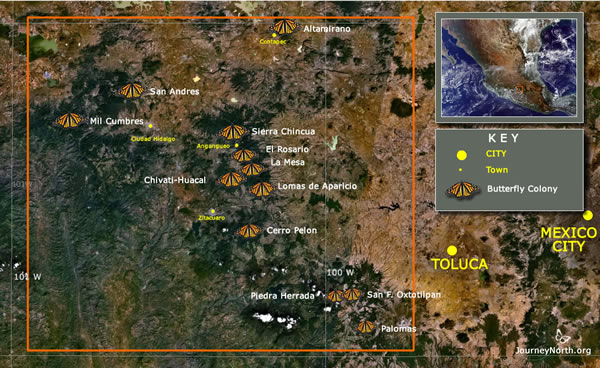Letter from Estela
Sierra Chincua Now Empty and Silent

The end of the season at Sierra Chincua Santuary.
Sierra Chincua Now Empty and Silent April 8, 2017 Dear Friends, The weekend is starting Easter time now. Ejidatarios and their families guarding and working in Sierra Chincua continued, as usual, passing by through Angangueo. In front of my house early in the morning, every single day on their way there and, during these very last days, they simply shouted loud to me without stopping their truck:
To which I responded every time:
Friday, April 7th : Nicolás Diaz Cruz, who was my guide the two last times I have visited the Sanctuary and who took me to the very bottom of the “Koala” site these last times to where Monarchs moved down so far away, passed by Angangueo Friday afternoon, knocked at my door and told me:
Saturday, April 8th: Up I drove today to Sierra Chincua. Nicolás was waiting for me; we hurried our way into the woods in the beautiful Saturday sunny morning. As we wento into the forest, I could see that the ponds and streams were now empty; no Monarchs drinking water as they usually do every morning all over the season, but a single one nearby at a humid place by mere casualty; seldom a lonesome Monarch would come up flying here and another one more ahead. As we reached “La Casa del Japonés” site, we walked sharp downhill northwards for about half an hour more.
We did reach the site after this 30 minute walk. Monarchs seemed to have moved back to the woods were they were one month ago now.
That it was, the last bunch of Monarchs had just left either Friday, April 7th, in the afternoon, or today, Saturday, April 8th, in the morning. I could hardly make some photos of the very lonesome and last ones in the only site they were overflying very much high up through the trees as if wandering around and prepared to leave at any moment. One thing to observe is that the perishing in this site, as well as in the other sites we passed by, not totally empty, was really scarce everywhere. It was at the very bottom of this pine tree where Nicolás pointed at, assuring they were still yesterday at, even forming several tiny clusters, that an evident and “fresh” perishing could be observed; other than that, it gave the impression that, on one side, predators had been really active at every site, and on the other side, perhaps perishing were not so very abundant, at least, not at all out of the normal standards. Every where around, the seeds of Oyamel trees fallen on the ground awake great hope in every guide and ejidatario of a natural self reforestation at the forest, and, when they happen to find a cone of seeds fallen on the ground, they take it preciously and spread the seeds all over the soil. Far into the distance, when a landscape area is passed by, the smoke of forest fires can be seen coming from the southern areas of our region, that is, Zitàcuaro’s Municipality surroundings, where locals clear areas of forest for making their avocado farms or ornamental nursery plants grow a little more, unfortunately, since besides extermining areas of woods, they are potential consumers of the water generated by the forests of our region. In summary, to close with for the season, the very last hours Monarchs were at the Sierra Chincua Sanctuary this season — still wrapping a pine tree trunk and tiny clusters — were sometime from noon-time and afternoon Friday (April 7) to to Saturday morning (April 8) at the latest. Overall, the final massive leaving from Sierra Chincua, seems to have taken place from April 3rd to 7th. In contrast, the remaining colony at “El Rosario” abandoned their overwintering sites on Sunday, April 2nd -- all at once. Whereas, it took that whole week days (April 3-8) for the ones in Sierra Chincua to leave! We all locals here know now that the huge community of Monarch volunteers, conservationists and researchers all along and across the Monarchs’ migration corridors in North America and Canada are now very happy and prepared to welcoming, depending on the latitudes they are, either the first Monarchs crossing the border or the next new generations starting this new year’s life cycle, supporting them exemplarily in their subsistance and successful reproduction cycle. Meanwhile, while swallows now make their noisy and joyful arrival to our region, all of our local people, and very specially the Ejidatario people guarding the overwintering forests are more and more proud of our land being the winter home for Monarchs, and show indeed at the same time, a real concern and will to assure, by all means, the permanence of our forests into the future, in order to make sure that Monarchs will always come back for the eyes of the future generations worldwide, being the Monarchs’ Sanctuaries here in Central México, proudly, part of the World’s Natural Heritage. I should now allow myself to thank you, and to tell you until next season, on behalf of all us here!!! Estela Romero
|
|
|||||||||||||||||
Copyright Journey North (journeynorth.org). All Rights Reserved.






